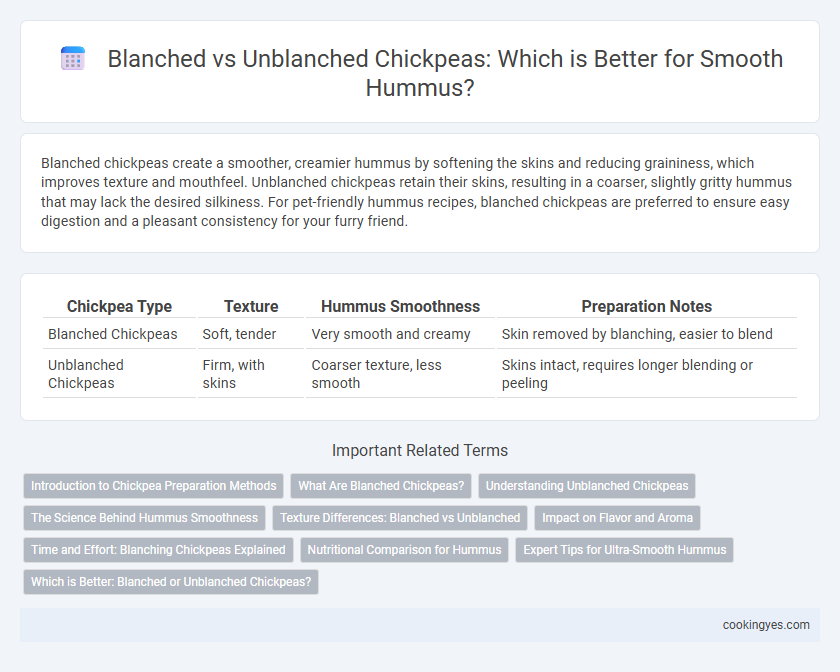Blanched chickpeas create a smoother, creamier hummus by softening the skins and reducing graininess, which improves texture and mouthfeel. Unblanched chickpeas retain their skins, resulting in a coarser, slightly gritty hummus that may lack the desired silkiness. For pet-friendly hummus recipes, blanched chickpeas are preferred to ensure easy digestion and a pleasant consistency for your furry friend.
Table of Comparison
| Chickpea Type | Texture | Hummus Smoothness | Preparation Notes |
|---|---|---|---|
| Blanched Chickpeas | Soft, tender | Very smooth and creamy | Skin removed by blanching, easier to blend |
| Unblanched Chickpeas | Firm, with skins | Coarser texture, less smooth | Skins intact, requires longer blending or peeling |
Introduction to Chickpea Preparation Methods
Blanched chickpeas are briefly boiled and peeled, resulting in a smoother and creamier hummus texture due to the removal of the chickpea skins, which can cause graininess. Unblanched chickpeas retain their skins, offering a nuttier flavor but potentially a coarser consistency in the final hummus. Choosing between blanched and unblanched chickpeas significantly impacts the smoothness and mouthfeel, influencing the overall quality of homemade hummus.
What Are Blanched Chickpeas?
Blanched chickpeas are chickpeas that have been briefly boiled and then quickly cooled to remove their outer skins, resulting in a smoother texture ideal for creamy hummus. This process eliminates the tough seed coat, which can contribute to graininess in traditional hummus made with unblanched chickpeas. Using blanched chickpeas enhances the overall silkiness and mouthfeel, making them a preferred choice for achieving perfectly smooth hummus.
Understanding Unblanched Chickpeas
Unblanched chickpeas retain their skins, contributing to a nuttier flavor but often result in a coarser hummus texture. The presence of the seed coat increases fiber content but can make blending more difficult, leading to less smooth hummus. For a creamier consistency, many chefs recommend peeling chickpeas despite the additional preparation time.
The Science Behind Hummus Smoothness
Blanched chickpeas enhance hummus smoothness by removing the tough outer skins, which reduces fiber content and allows for a creamier texture due to less particle interference. The science behind this process involves the breakdown of cell walls and release of starches during cooking, which blend more easily, creating a velvety consistency. In contrast, unblanched chickpeas retain their skins, contributing to a coarser texture and less uniform emulsification in the final hummus.
Texture Differences: Blanched vs Unblanched
Blanched chickpeas yield a smoother and creamier hummus texture due to their softened skins, which blend more easily and reduce graininess. Unblanched chickpeas retain their skins, contributing to a coarser, slightly gritty texture in the final hummus. This textural difference significantly impacts the mouthfeel and perceived quality of homemade hummus.
Impact on Flavor and Aroma
Blanched chickpeas create a smoother hummus texture by softening the skins, resulting in a creamier mouthfeel without bitterness. Unblanched chickpeas retain their skins, contributing a slightly earthier and nuttier flavor but a grainier texture. The blanching process reduces the beany aroma, enhancing the subtle, savory essence of tahini and garlic in the final hummus.
Time and Effort: Blanching Chickpeas Explained
Blanched chickpeas require an extra boiling step that softens their skins, significantly reducing the overall blending time needed to achieve creamy hummus. This process involves briefly boiling the chickpeas after cooking and then cooling them, which makes peeling easier and enhances hummus texture without extensive blending effort. Using blanched chickpeas streamlines preparation by minimizing blending duration while producing smoother, less gritty hummus compared to unblanched chickpeas.
Nutritional Comparison for Hummus
Blanched chickpeas offer a smoother texture in hummus due to their softer skin, which is removed during blanching, while unblanched chickpeas retain more fiber and nutrients found in the skin. Nutritionally, unblanched chickpeas provide higher amounts of dietary fiber, antioxidants, and certain vitamins such as folate and B vitamins, enhancing the overall health profile of hummus. Choosing blanched chickpeas may improve hummus creaminess, but unblanched chickpeas contribute greater nutritional density, particularly in micronutrients and phytochemicals.
Expert Tips for Ultra-Smooth Hummus
Using blanched chickpeas significantly enhances hummus smoothness by removing the tough outer skins, resulting in a creamier texture preferred by chefs. Expert tips emphasize boiling chickpeas until tender before blending and optionally peeling skins for ultra-smooth consistency. Incorporating baking soda during cooking softens the legumes further, optimizing the hummus's velvety mouthfeel.
Which is Better: Blanched or Unblanched Chickpeas?
Blanched chickpeas are generally better for achieving hummus smoothness due to their softened skins, which reduce graininess and create a creamier texture. Unblanched chickpeas retain their skins, leading to a coarser consistency and slightly bitter taste in hummus. For optimal smoothness, removing the skins through blanching or skinning after cooking is recommended.
Blanched Chickpeas vs Unblanched Chickpeas for Hummus Smoothness Infographic

 cookingyes.com
cookingyes.com